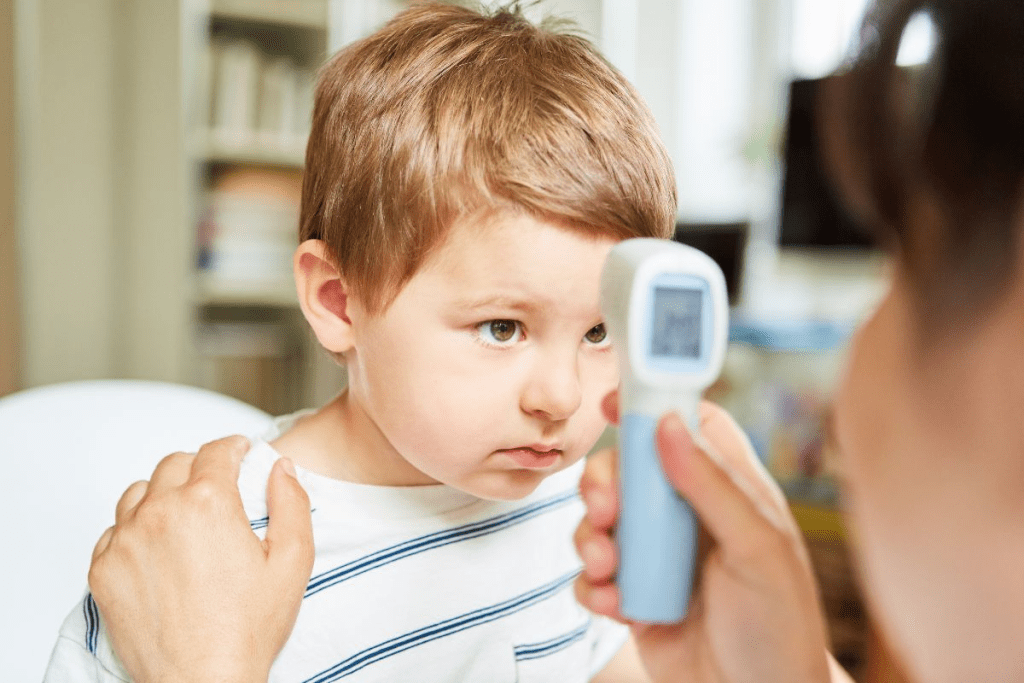Last Updated on November 14, 2025 by
When fever hits, finding relief is key. Studies show that a warm bath can help how to break a fever a fever, mainly in kids. This method is backed by science and offers a comforting way to manage fever.
A warm bath can cool down your body and help you relax. It makes resting and getting better easier. Along with hydrotherapy, rest, staying hydrated, and using medicines like acetaminophen or ibuprofen are also important.

Knowing the best ways to handle fever can greatly improve recovery speed and comfort.
When the body finds an invader, it often starts a fever. This is a complex reaction to make the body less welcoming to the invader. It’s a key defence against infections.
The body’s temperature center, in the hypothalamus, sets a higher temperature during a fever. This makes the body produce and keep heat. It does this by narrowing blood vessels, which reduces heat loss.
The higher temperature helps the immune system fight infections. It does this by stimulating the production of white blood cells and activating various immune responses.

The body raises its temperature to make it harder for pathogens to multiply. Higher temperatures can slow down the growth of some bacteria and viruses. This gives the immune system an edge.
Also, fever boosts the activity of interferons. These proteins are vital in fighting viruses.
While fever is helpful, sometimes it needs to be lowered. High fevers, over 103 °F (39.4 °C), can be uncomfortable. They can also cause problems, such as in the elderly, young children, and those with chronic conditions.
Lowering the fever can ease symptoms and comfort the person. But it’s important to do it with a doctor’s advice. This prevents hiding serious infection symptoms.
Understanding fever and its role in fighting infection is key to managing it well. Rest and staying hydrated are important. They help the body focus on fighting the infection. Knowing when and how to safely lower fever helps manage symptoms and support the body’s fight against infection.
Breaking a fever can be done with medical treatments and natural methods like hydrotherapy. Knowing these methods is key to managing fever well.
Doctors often use medicines like acetaminophen or ibuprofen to lower a fever. These drugs help change the body’s temperature setting.
Non-medical ways include hydrotherapy, which uses water to control body heat. A warm bath can help relieve fever and improve sleep.
Hydrotherapy, like a warm bath, is good for managing fever. It cools the body by increasing heat loss. The water should be lukewarm, not cold, to avoid raising the body’s temperature.
Techniques for reducing fever work differently for everyone. Medication can be quick, but hydrotherapy is natural and comforting.
Choosing between medical and natural methods depends on the severity of the fever and the person’s health. Often, using both is the best way.
Recent studies have shown that warm baths can help lower a fever. The use of warm water for fever relief has caught the attention of doctors. By looking at recent research, we can see how warm baths help manage fever.
A 2021 study found that warm water foot baths lowered body temperature in kids. This study shows that hydrotherapy can help manage fever in children without medicine. The study found a significant drop in body temperature, showing warm baths can be effective in reducing fever in kids. For more on managing fever, check out the National Institutes of Health.
A systematic review by Witten/Herdecke University also supports warm baths for fever relief. The review gathered evidence from many studies. It found that warm baths can be a helpful addition to fever treatment.
The review highlights the value of non-medical treatments like warm baths. This is important when medicine isn’t suitable or preferred.
Warm water baths can change core body temperature in several ways. First, the warm water causes blood vessels near the skin to widen. This helps to release heat from the body, which can lower core body temperature.
Also, the relaxation from warm water can reduce stress. This stress reduction may help lower the fever, too.
It’s important to understand how warm water affects the body to see its role in reducing fever. This knowledge helps people decide to use warm baths for fever relief. It can reduce the need for medicine and make feeling sick more comfortable.
To safely and effectively use warm baths for fever reduction, understanding the proper techniques for different ages is essential. Administering a warm bath can be very helpful for children. But the technique must be adapted based on their age and sensitivity.
The ideal water temperature for a warm bath to reduce fever is around 40 °C (104 °F). It’s very important not to exceed this temperature to avoid causing discomfort or potentially worsening the fever. For adults, the water should feel warm but not hot. For children, it’s essential to test the water with your hand to ensure it’s not too hot.
A warm bath for fever reduction should typically last between 15 and 20 minutes. It’s recommended to repeat the bath every few hours if necessary, but always monitor the individual’s temperature and overall condition. For children, it’s often suggested to start with shorter durations and adjust as needed.
When it comes to children, extra caution is necessary. The water should be tested for temperature, and the child should be closely monitored during the bath. For adults, the primary concern is ensuring the water is not too hot and staying hydrated during and after the bath.
The choice between a cool and warm bath depends on the individual’s condition.
“If the fever is extremely high, a cool bath might be more effective. But, for most cases, a warm bath is recommended as it helps in gradually reducing the fever without causing sudden drops in body temperature.”

By following these guidelines and adapting the warm bath technique to the individual’s age and condition, it’s possible to effectively reduce fever and provide relief.
Warm baths can be a great addition to your fever plan. They help reduce fever and make you feel better. This makes them a good choice for symptom relief.
For effective fever relief, warm baths should be part of a bigger plan. This includes getting medical help for long or high fevers. Knowing how to use warm baths can help you manage fever better.
Using a warm bath can be a good way to fight a fever. To get the most out of it, follow the right water temperature and time. Adding warm baths to your plan can help lower your fever and make you feel more comfortable.
To break a fever, rest, drink lots of water, and use medicine are key. Taking a warm bath can also help lower your fever.
When you have a fever, your body gets hotter to fight off germs. This is a natural way to defend against infections.
You might need to lower your fever if it’s very high or lasts a long time. Or if you have other symptoms that worry you. Always talk to a doctor about how to handle your fever.
Hydrotherapy uses water to improve health. A warm bath is a form of hydrotherapy. It can help cool your body and reduce fever.
For a warm bath, the water should be about 40 °C. Stay in the bath for 15-20 minutes. How often you take a bath depends on how you feel.
No, cold baths are not good for lowering fever. They can make you shiver, which raises your body temperature and makes the fever worse.
Yes, warm baths can help kids with a fever. But make sure the water isn’t too hot. Always watch a child in the bath.
How often you take a warm bath depends on how you feel. Watch your body’s response and adjust as needed.
Yes, you can use medicine like acetaminophen or ibuprofen with warm baths. But always follow the dosage and talk to a doctor if you’re unsure.
To manage fever, drink lots of water, rest, and use medicine as directed. Also, talk to a doctor for advice on how to handle your fever.
Sunar, S. (2017). The effect of warm water foot bath therapy on reduction of body temperature among children with fever. International Journal of Clinical Pediatric Dentistry, 10(3), 293-298. https://core.ac.uk/download/481608756.pdfWulanningirum, & Ardianti, D. (2024). Effectiveness of warm water foot bath therapy on body temperature reduction among children with fever. International Conference on Health, Education and Technology Proceedings, 75-80. https://ejurnal2.poltekkestasikmalaya.ac.id/index.php/ichet/article/download/611/324/2343German Commission for Hospital Hygiene and Infection Prevention (KRINKO). (2022). Fever in children: Learn more ” How can you reduce a fever? InformedHealth.org. https://www.ncbi.nlm.nih.gov/books/NBK279453/
Subscribe to our e-newsletter to stay informed about the latest innovations in the world of health and exclusive offers!